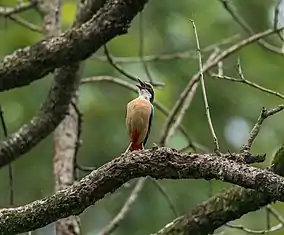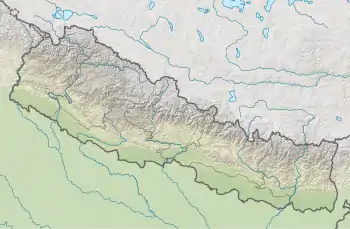| Parsa National Park | |
|---|---|
 Indian pitta at Parsa National Park | |
 Parsa National Park | |
| Location | Nepal |
| Nearest city | Birgunj |
| Coordinates | 27°28′N 84°20′E / 27.467°N 84.333°E |
| Area | 627.39 km2 (242.24 sq mi) |
| Established | 1984 as Wildlife Reserve, 2017 as National Park |
| Governing body | Department of National Parks and Wildlife Conservation |
Parsa National Park is a protected area in the Inner Terai lowlands of south-central Nepal. It covers an area of 627.39 km2 (242.24 sq mi) in the Parsa, Makwanpur and Bara districts and ranges in altitude from 435 m (1,427 ft) to 950 m (3,120 ft) in the Siwalik Hills. It was established as a wildlife reserve in 1984. A bufferzone declared in 2005 comprises 285.3 km2 (110.2 sq mi).[1] In 2015, the protected area has been extended by 128 km2 (49 sq mi).[2] Since 2017, it has the status of a National Park.
In the north of the protected area the Rapti River and Siwalik Hills form a natural boundary to human settlements. In the east it extends up to the Hetauda – Birgunj highway. In the south, a forest roads demarcates the boundary. Adjacent to the west is Chitawan National Park. Together with the Indian Tiger Reserve Valmiki National Park, the coherent protected area of 2,075 km2 (801 sq mi) represents the Tiger Conservation Unit (TCU) Chitwan-Parsa-Valmiki, which covers a 3,549 km2 (1,370 sq mi) block of alluvial grasslands and subtropical moist deciduous forests.[3]
Before being converted to a protected area, the region used to be a hunting ground of the ruling class.[1][4]
Vegetation
The typical vegetation of the park is tropical and subtropical forest types with sal forest constituting about 90% of the vegetation. Chir pine grows in the Churia Hills. Khair, sissoo and silk cotton trees occur along watercourses. Sabai grass grows well on the southern face of the Churia Hills.[4]
An estimated 919 species of flora have been recorded including 298 vascular plants, 234 dicots, 58 monocots, five pteridophytes, and one gymnosperm.[1]
Fauna
In May 2008, a census conducted in the reserve confirmed the presence of 37 gaurs.[5]
In 2008, four adult Bengal tigers were estimated to be resident in the protected area.[6] A camera trapping survey conducted in February 2017 for three months revealed the presence of 19 Bengal tigers. This indicates the rise in tiger population by three times in three years.[7]
Three Indian rhinoceros were recorded in the park.[8]
References
- 1 2 3 Bhuju, U. R.; Shakya, P. R.; Basnet, T. B.; Shrestha, S. (2007). Nepal Biodiversity Resource Book. Protected Areas, Ramsar Sites, and World Heritage Sites (PDF). Kathmandu: International Centre for Integrated Mountain Development, Ministry of Environment, Science and Technology, in cooperation with United Nations Environment Programme, Regional Office for Asia and the Pacific. ISBN 978-92-9115-033-5. Archived from the original (PDF) on 2011-07-26. Retrieved 2018-12-14.
- ↑ Anonymous. 2015. Good news for tigers as Nepal extends Parsa Wildlife Archived 2018-07-09 at the Wayback Machine. Wildlife Extra, 9 September 2015.
- ↑ Wikramanayake, E.D., Dinerstein, E., Robinson, J.G., Karanth, K.U., Rabinowitz, A., Olson, D., Mathew, T., Hedao, P., Connor, M., Hemley, G., Bolze, D. (1999). Where can tigers live in the future? A framework for identifying high-priority areas for the conservation of tigers in the wild. Archived 2012-03-10 at the Wayback Machine In: Seidensticker, J., Christie, S., Jackson, P. (eds.) Riding the Tiger. Tiger Conservation in human-dominated landscapes. Cambridge University Press, Cambridge. hardback ISBN 0-521-64057-1, paperback ISBN 0-521-64835-1. Pages 255–272 "Archived copy". Archived from the original on April 6, 2012. Retrieved 2012-03-10.
{{cite web}}: CS1 maint: archived copy as title (link) - 1 2 Majupuria, T.C., Kumar, R. (1998) Wildlife, National Parks and Reserves of Nepal. S. Devi, Saharanpur and Tecpress Books, Bangkok. ISBN 974-89833-5-8. Pages 245–248.
- ↑ WWF Nepal (2008) Gaur count in Parsa Wildlife Reserve EcoCircular Newsletter Vol. 44 No. 8, June 2008
- ↑ Global Tiger Initiative (2010) National Tiger Recovery Program: T x 2 by 2022 Nepal, Draft Archived 2011-07-06 at the Wayback Machine
- ↑ "The tiger population in Nepal's Parsa National Park is recovering rapidly". 16 August 2017.
- ↑ "Nepal achieves 21% increase in rhino numbers". WWF Nepal. World Wildlife Fund. 5 May 2015. Retrieved 19 February 2023.